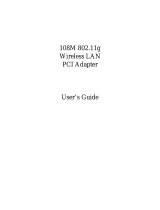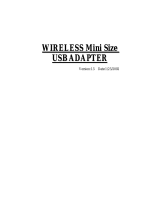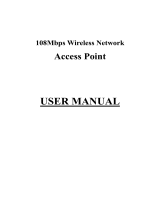Page is loading ...


2 NP642 IEEE 802.11g PCI Adapter
YML785 Rev1
Caution
The NetComm NP642 must be installed and operated in accordance with
the instructions provided in this Quick Start Guide. Damage caused by
incorrect or careless installation is not covered by warranty.
Static Electricity
Computers are very sensitive to static electricity which may be discharged
by the user when the internal circuitry is touched. Ensure that you have
discharged any static prior to touching the computer’s PCI slots and
to removing the NetComm NP642 from its static bag, by touching an
earthed object first. This can be the computer’s Power Supply provided
the power is switched off at the wall, but the power cord is connected to
the power socket; static will be discharged through the power cord’s earth
connection.

NP642 IEEE 802.11g PCI Adapter 3
YML785 Rev1
Contents
INTRODUCTION ...................................................................................... 4
Wireless Terminology .......................................................................... 5
System Requirements ......................................................................... 7
GETTING TO KNOW YOUR NP642 ............................................................... 8
Package Contents ............................................................................... 8
NP642 LED Indicators .......................................................................... 9
HARDWARE INSTALLATION ..................................................................... 10
PCI Card Installation Instructions ........................................................ 10
Connecting the Antenna .................................................................... 11
SOFTWARE INSTALLATION ...................................................................... 12
Windows 98se/ME/2000/XP Utility and Driver Installation ....................... 12
USING THE WIRELESS UTILITY ............................................................... 14
I. Link Information ............................................................................ 14
II. Configuration............................................................................... 16
III. Advanced ................................................................................... 19
IV. Site Survey ................................................................................. 22
V. About ......................................................................................... 24
APPENDIX A: Glossary .......................................................................... 25
APPENDIX B: Registration and Warranty Information ................................. 32
Contact Information .......................................................................... 32
Copyright Information ....................................................................... 32
Customer Information ....................................................................... 33
Product Warranty .............................................................................. 34
Limitations of Warranty ..................................................................... 35

4 NP642 IEEE 802.11g PCI Adapter
YML785 Rev1
INTRODUCTION
Congratulations on your purchase of the NP642 108Mbps IEEE 802.11g Wireless PCI
Card.
This manual is designed to help familiarise users with the product and offers detailed
operational and installation instructions, so please keep it for future reference.
With the NP642 Wireless (IEEE 802.11g) PCI Card, a computer can communicate
with the Network wirelessly. User-friendly utility software is bundled with the NP642
providing configuration, monitoring and diagnostic options.
The NP642 provides data transfer rates of up to 108 Mbps, which is 10 times faster than
most existing Wi-Fi wireless networks.
Designed to handle bandwidth-intensive applications and multimedia content, the NP642
eliminates the need for unsightly ethernet cables while providing fast and secure network
transfer rates.
The NP642 has the most advanced security features available today with 128 bit WEP
encryption and WPA security.
The Wireless PCI Card configuration is easy to configure for peer-to-peer networks,
suitable for a small number of users, or for full infrastructure networks that allow broad
area roaming.

NP642 IEEE 802.11g PCI Adapter 5
YML785 Rev1
Wireless Terminology
Wireless Standards
802.11, 802.11b and 802.11g all refer to a series of standards which govern a
common method of creating wireless local area networks (WLANs).
802.11b and 11g are the most common WLAN types, with 11g being the later and
faster of the two standards with a maximum transmission rate of 54Mbps.
The NP642 is faster again as it is built around a processor which ‘turbo-charges’
transmission rates up to 108Mbps.
802.11g is ‘backward compatible’ with 802.11b, which means that the two
standards are able to communicate, albeit at the lower 11Mbps rate of the 11b
standard.
The NP642 can communicate with both kinds of device at their maximum rate,
and with other ‘turbo-charged’ devices at the much higher rate of 108Mbps.
Wireless Security Terms
The Advanced Features of the NP642 include the ability to select from several
types of Wireless Security.
WEP WEP stands for Wired Equivalent Privacy. Introduced
with 802.11b, WEP uses encryption to protect data
confidentiality by way of pre-shared keys (passwords or
pass-phrases) that are entered at both ends. Superseded by
WPA and 802.11i but still in use.

6 NP642 IEEE 802.11g PCI Adapter
YML785 Rev1
WPA WPA stands for Wi-Fi Protected Access - authorizes and
identifies users based on a secret key that changes automatically
at a pre-defined interval. This is called TKIP (Temporal Key
Integrity Protocol) to change the temporal key every 10,000
packets (= unit of data.) Keys can either be pre-shared or
established by a RADIUS Server.
RADIUS RADIUS is part of 802.11i security; this is a wireless standard
which is only concerned with wireless security standards.
Authentication is based around a secure server with a challenge-
and-response method of interaction which verifies the identity
of the client wishing to connect to the network. If you wish to
connect to a RADIUS server ask the Network Administrator for
details. RADIUS servers are not usually used as part of home
networks.

NP642 IEEE 802.11g PCI Adapter 7
YML785 Rev1
System Requirements
• Desktop computer with available 32bit PCI slot.
• Windows 98SE, ME, 2000, XP
• 32Mb of memory and a 300MHz processor
• 20Mb spare disk storage
• CD-ROM Drive
Caution
The NetComm NP642 must be installed and operated in accordance with
the instructions provided in this Quick Start Guide. Damage caused by
incorrect or careless installation is not covered by warranty.
Static Electricity
Computers are very sensitive to static electricity which may be discharged
by the user when the internal circuitry is touched. Ensure that you have
discharged any static prior to touching the computer’s PCI slots and
to removing the NetComm NP642 from its static bag, by touching an
earthed object first. This can be the computer’s Power Supply provided
the power is switched off at the wall, but the power cord is connected to
the power socket; static will be discharged through the power cord’s earth
connection.

8 NP642 IEEE 802.11g PCI Adapter
YML785 Rev1
GETTING TO KNOW YOUR NP642
This chapter provides unpacking and setup information for the NP642 Wireless PCI Card.
Package Contents
Open the box of the Wireless PCI Card and carefully unpack it. The box should contain
the following items:
� One 108Mbps 802.11g Wireless PCI Card
with removable antenna
� One Installation CD, including Utility
Software and User Guide.
If any item is found missing or damaged, please contact your local reseller for
replacement.

NP642 IEEE 802.11g PCI Adapter 9
YML785 Rev1
NP642 LED Indicators
LED Indicator Description
Power (PWR) The PWR indicator lights green to indicate that it is receiving
power from the PCI slot. If the PWR indicator light is off, it is not
receiving power.
ACT (Activity) The ACT indicator blinks green while the Wireless PCI Card is
transmitting data.

10 NP642 IEEE 802.11g PCI Adapter
YML785 Rev1
HARDWARE INSTALLATION
PCI Card Installation Instructions
1. Shut down the computer, unplug the power cord, and remove the chassis cover.
2. Insert the contact edge of the Wireless PCI Card into the available PCI Bus Master
Expansion slot. Press the card firmly into the connector so that the card’s contacts are
fully seated in the PCI slot connector.
3. Install the bracket screw and secure the card to the computer chassis.
4. Replace the computer’s cover.
5. Switch the computer power on. Windows will display a ‘Found New Hardware’ dialog
box. Click Cancel to dismiss and proceed with installation of the driver from the CD-
ROM as described on Page 11, after attaching the antenna.

NP642 IEEE 802.11g PCI Adapter 11
YML785 Rev1
Connecting the Antenna
Before continuing with the Software Installation section, you will need to connect the
antenna
1. The antenna has a retaining nut which must be screwed into the connector on the back
of the card. Place the screw retaining nut over the antenna connection on the rear of
the NB642 and turn it clockwise.
Note: Do not over-tighten the attaching nut - but do make sure that
you have screwed it all the way to its end.
2. Adjust the antenna to a 90
o
angle.
Note: Please note that you may have to rotate the complete antenna
assembly to do this and have the antenna pointing vertically.
Screw
retaining nut
clockwise
over the
antenna
connection
Bend
antenna
to a 90
o
angle

12 NP642 IEEE 802.11g PCI Adapter
YML785 Rev1
SOFTWARE INSTALLATION
This section will guide you through the driver and utility installation procedure for the
NP642 Wireless PCI Card.
Windows 98se/ME/2000/XP Utility and Driver Installation
1. Insert the Driver and Utility CD-ROM into the CD-ROM Drive. The driver and util-
ity setup menu should start up and install the driver. Depending on your operating
system, you may need to install the software manually. Go to your Windows start
menu and select “Run”. Type “D:\Utility\Setup.exe” in the dialog box (where D:\ is
the letter of your CD-ROM drive) and click OK.
2. If you need to install the driver manually, refer your Windows Operating System,
(OS) to the following CD-Rom directory path: D:\Driver\<Windows OS>\net5211.inf
(where D:\ is the letter of your CD-ROM drive).
3. The Install Shield Wizard screen will appear. Click “Next” to continue.
4. The installation program will help you setup the Wireless PCI utility.
Windows XP has its own Wireless Utility. You can either use the Windows XP utility
or the provided utility.
5. Once the Wireless PCI Card is installed you will find a new icon on the Windows task
bar. The colour of the icon represents the strength of the wireless signal.

NP642 IEEE 802.11g PCI Adapter 13
YML785 Rev1
Icon Description
If the Icon is completely Green, you have excellent coverage and
performance.
If the icon is yellow, the signal strength has a fair coverage and
performance.
If the icon has no colour, signal strength is poor.

14 NP642 IEEE 802.11g PCI Adapter
YML785 Rev1
USING THE WIRELESS UTILITY
I. Link Information
Launch the utility program by double clicking the utility icon in the Windows task bar.
The following window is displayed after launching the Utility program.
Field Description
Status: Shows the BSSID (or Mac address) of the adaptor, which can be
used to identify it on the wireless network.
SSID: Shows current SSID, which must be the same for the all wireless
devices in order for communication to be established.
Frequency: Shows the current frequency used for the wireless network.

NP642 IEEE 802.11g PCI Adapter 15
YML785 Rev1
Field Description
Wireless Mode: Shows the current wireless mode used for wireless
communication.
Encryption: Shows the current encryption mode used in the wireless network.
TxRate: Shows the current data rate used for transmitting.
Channel: Shows the current communication channel.
Link Quality: Shows the link quality of the NP642 Wireless PCI card with the
Access Point when operating under Infrastructure mode.
Signal Strength: Shows the strength of the wireless signal between the NP642
Wireless PCI card and the Access Point.
Data Rate: Shows the statistics of the data transfer rate. The calculation is
based on the number of packets transmitted and received.

16 NP642 IEEE 802.11g PCI Adapter
YML785 Rev1
II. Configuration
The configuration page enables you to set the basic parameters for your connection.
Field Description
SSID: Service Set Identifier, which is a unique name shared among
all clients and nodes in a wireless network. The SSID must be
identical for each client and node in the wireless network. Give
your network a name which you will remember but which does
not obviously identify it to the outside world.
Wireless Mode: There are two types available for selection:
● Infrastructure – to establish wireless communication with
the LAN and other wireless clients through the use of Access
Points.

NP642 IEEE 802.11g PCI Adapter 17
YML785 Rev1
Field Description
● Ad-Hoc – to establish peer-to-peer wireless communication
directly with other wireless client devices such as other
computers with wireless cards.
Ad-Hoc Band: There are three bands available for selection- 11B, 11G and 11G
Turbo. Choice depends on the type of wireless equipment you
wish to connect to. Check the documentation of the associated
equipment to verify details.
Channel: The channel value that the PCI card will operate in. Australian
Users should select the Channel Range 1-13 and all stations
on the WLAN need to be on the same channel if they are to
communicate.
Tx Rate: Select the data rate for data transmission.
Power Mode: There are 3 modes to choose from:
● Continuous Access Mode (default) – the PCI card is
constantly operating with full power and it consumes the most
power.
● Maximum Power Save – the PCI card consumes the least
power and only operates when there is wireless network
activity.
● Power Save – the PCI card consumes a moderate level of
power.

18 NP642 IEEE 802.11g PCI Adapter
YML785 Rev1
Field Description
Preamble: Select Long Preamble or Short & Long Preamble type. Leave as
default unless advised otherwise by your Network Administrator.
Support Band: There are three functions for you to select, including 11B, 11G and
eXtended Range. The default setting is 11B, 11G and eXtended
Range enabled, which is interoperable with both 11B and 11G
devices, and provides a connectivity range of 500m.
Note: You must select at least 11B or 11G to support your wireless
connection.

NP642 IEEE 802.11g PCI Adapter 19
YML785 Rev1
III. Advanced
In the Advanced page you can configure advanced settings for the NP642 wireless PCI
Card
Field Description
Encryption: There are four options available: Disable (WEP), Enable
(WEP), WPA and WPA-PSK. The default setting is set to
“Disable”. Enable and Disable refer to WEP data encryption
feature. If Enable is selected, you will be required to select the
Authentication mode from the drop down list. If WPA is selected,
configuration is enabled. Select the “configuration” button.
You will then be prompted with the following pop up window.

20 NP642 IEEE 802.11g PCI Adapter
YML785 Rev1
Select the certificate that you wish to use and enter the server
name and login name; this refers to RADIUS Server technology
which is generally not in use in the home environment; check with
your Network Administrator if you are required to enter this in
order to log on to a secure network.
If WPA-PSK is selected, click the configuration button. You will
then be prompted with the following pop up window.
1/36




